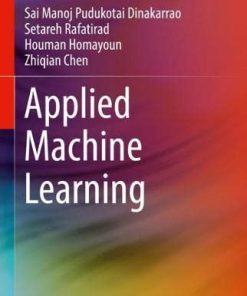Computer Architecture for Scientists Principles and Performance 1st Edition by Andrew Chien ISBN 9781316518533 1316518531
$50.00 Original price was: $50.00.$25.00Current price is: $25.00.
Computer Architecture for Scientists Principles and Performance 1st Edition by Andrew Chien – Ebook PDF Instant Download/Delivery: 9781316518533 ,1316518531
Full download Computer Architecture for Scientists Principles and Performance 1st Edition after payment

Product details:
ISBN 10: 1316518531
ISBN 13: 9781316518533
Author: Andrew Chien
Computer Architecture for Scientists Principles and Performance 1st Edition Table of contents:
1 Computing and the Transformation of Society
1.1 Computing Transforms Society and Economy
1.1.1 Home
1.1.2 Automobiles and Transportation
1.1.3 Commerce
1.2 Computing Transforms Science and Discovery
1.3 Extraordinary Characteristics of Computing
1.4 What is Computer Architecture?
1.5 Four Pillars of Computer Performance: Miniaturization, Hidden Parallelism, Dynamic Locality, and
1.6 Expected Background
1.7 Organization of the Book
1.8 Summary
1.9 Problems
2 Instructions Sets, Software, and Instruction Execution
2.1 Computer Instruction Sets
2.2 Computer Systems Architecture
2.3 Instruction Set Architecture: RISC-V Example
2.3.1 Computation Instructions
2.3.2 Conditional Control and Procedure Linkage Instructions
2.3.3 Memory Instructions
2.4 Machine Instructions and Basic Software Structures
2.4.1 Implementing Basic Expressions
2.4.2 Implementing Data Structures: Structs and Objects
2.4.3 Implementing One- and Multi-dimensional Arrays
2.4.4 Implementing Conditional Iterative Constructs: Loops
2.4.5 Implementing Procedure Call and Return and the Stack
2.5 Basic Instruction Execution and Implementation
2.5.1 Sequential State and Instruction Execution
2.5.2 Hardware Implementation of Instruction Execution
2.6 Speeding Up Instruction Execution and Program Performance
2.7 Summary
2.8 Digging Deeper
2.9 Problems
3 Processors and Scaling: Small is Fast!
3.1 Miniaturization and Information Processing
3.2 What Is the Natural Size of a Computer?
3.2.1 Example: Bit Size and Speed
3.2.2 Shrinking Computers
3.3 Computer Size and Speed
3.3.1 Smaller Computers Are Faster
3.3.2 Example: Applying the Size and Clock Period Model
3.3.3 Size Scaling Computers from Room-Sized to a Single Chip
3.3.4 Size Scaling Single-Chip Computers: The Power Problem and Dennard’s Solution
3.3.5 The End of Dennard Scaling
3.4 Computer Size and Power Consumption
3.5 Size in Other Technologies
3.6 Tiny Computers Enable an Explosion of Applications
3.7 Summary
3.8 Digging Deeper
3.9 Problems
4 Sequential Abstraction, But Parallel Implementation
4.1 Sequential Computation Abstraction
4.1.1 Sequential Programs
4.1.2 Instruction-Level Parallelism: Pipelining and More
4.1.3 Data Dependence and the Illusion of Sequence
4.2 The Illusion of Sequence: Renaming and Out-of-Order Execution
4.2.1 Variable and Register Renaming
4.2.2 Implementing Register Renaming: The Reorder Buffer
4.2.3 Limits of Out-of-Order Execution
4.3 Illusion of Causality: Speculative Execution
4.3.1 Branch Prediction
4.3.2 Speculative Execution
4.3.3 Accurate Branch Predictors
4.3.4 Security Risks of Speculation: Spectre and Meltdown
4.4 Summary
4.5 Digging Deeper
4.6 Problems
5 Memories: Exploiting Dynamic Locality
5.1 Memory Technologies, Miniaturization, and Growing Capacity
5.2 Software and Applications Demand Memory Capacity
5.3 Memory System Challenges: The Memory Wall
5.4 Memory Latency
5.4.1 Warping Space–Time (Caches)
5.4.2 Dynamic Locality in Programs
5.4.3 Address Filters (Caches)
5.4.4 The Effectiveness of Filters (Caches)
5.4.5 Implementing Caches (Warping and Filtering)
5.4.6 Recursive Filtering (Multi-level Caches)
5.4.7 Modeling Average Memory Hierarchy Performance
5.5 Why Caches Work so Well and Programming for Locality
5.6 Measuring Application Dynamic Locality and Modeling Performance
5.6.1 Measuring Dynamic Locality: Reuse Distance
5.6.2 Reuse Distance and Dynamic Locality
5.6.3 Modeling an Application’s Memory Performance Using Reuse Distance
5.6.4 Tuning a Program for Dynamic Locality
5.7 Access Rate and Parallel Memory Systems
5.8 Summary
5.9 Digging Deeper
5.10 Problems
6 The General Purpose Computer
6.1 A Commercial Processor: Intel Skylake
6.2 A Commercial Memory Hierarchy: Intel Skylake
6.2.1 Caches and Power
6.3 CPUs Are General Purpose Computers
6.4 Perspective: Mathematical Universality and Complexity
6.5 Summary
6.6 Digging Deeper
6.7 Problems
7 Beyond Sequential: Parallelism in MultiCore and the Cloud
7.1 The End of Dennard Scaling and the Shift to Parallelism
7.2 Parallel Single-Chip Computers: Multicore CPUs
7.2.1 Example: AMD Ryzen Multicore Chip and System
7.3 Programming Multicore Computers: OpenMP and pthreads
7.3.1 OpenMP: Pragma-Based Parallelism
7.3.2 pthreads: Explicit Thread-Parallelism
7.3.3 Challenging Parallelism in a Single Multicore CPU
7.3.4 Simpler Use of Multicore: Libraries and Servers
7.4 Million-Way Parallelism: Supercomputers and the Cloud
7.5 Efficient Parallelism: Computation Grain Size
7.6 Programming Cloud Computers: Coarse-Grained Parallelism
7.6.1 Three-Tier Web: Scalable Web Services
7.6.2 Scale-Out Map–Reduce (Hadoop and Spark)
7.6.3 Microservices: Modular Reliability and Evolution
7.6.4 Serverless (Function-as-a-Service)
7.7 Summary
7.8 Digging Deeper
7.9 Problems
8 Accelerators: Customized Architectures for Performance
8.1 The Emergence of Accelerators
8.1.1 Accelerator Hardware Opportunities
8.1.2 Programming and Software Challenges
8.2 Parallelism Accelerators
8.2.1 The Architecture of GPUs
8.2.2 Diverse GPUs and Performance
8.3 Machine Learning Accelerators
8.3.1 Google’s Tensor Processing Unit
8.3.2 Cerebras CS-2: A Wafer-Scale Machine Learning Accelerator
8.3.3 Small Machine Learning Accelerators (Edge)
8.4 Other Opportunities for Acceleration
8.5 Limitations and Drawbacks of Accelerated Computing
8.6 Summary
8.7 Digging Deeper
8.8 Problems
9 Computing Performance: Past, Present, and Future
9.1 Historical Computer Performance
9.2 Future Computer Performance: Opportunities for Performance Increase
9.2.1 Hardware Scaling and Opportunities
9.2.2 Resulting Programming and Software Challenges
9.3 New Computing Models
9.3.1 Higher-Level Architecture
9.3.2 Quantum Computing
9.3.3 Neuromorphic Computing
9.4 Summary
9.5 Digging Deeper
9.6 Problems
Appendix RISC-V Instruction Set Reference Card
References
Index
People also search for Computer Architecture for Scientists Principles and Performance 1st Edition:
computer architecture for scientists principles and performance pdf
computer science architect
what computer do architects use
architecture computer science
architecture computer science definition
Tags: Andrew Chien, Computer Architecture, Scientists, Performance
You may also like…
Computers - Computer Science
Uncategorized
Science (General)
Noncooperative Game Theory An Introduction for Engineers and Computer Scientists João P. Hespanha
Computers - Artificial Intelligence (AI)
Computers - Computer Science
Computers - Organization and Data Processing
Computers - Computer Science











